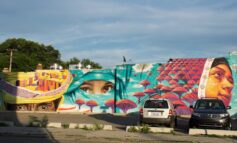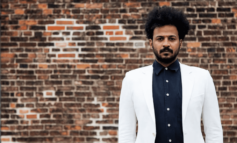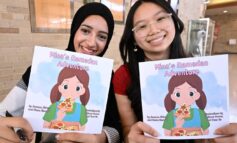
Crescents, crosses and stars of David hang like braids from her head. Shades of orange and red make her hair striking against the white canvas.
Her eyes are bright and blue. They’re looking away and seemingly filled with something. Hope? Maybe wisdom. Perhaps longing.
I am Syria.
She stands next to the canvas. She looks at the woman she painted. With red hair and blue eyes, she resembles the woman she painted.
She is Syria.
She is also Nada Odeh, a 40-year-old artist from Damascus who created a collection of paintings that juxtapose figures of fairy tales and royalty with refugee camps.
Her work highlights the contradictions she sees in the Syrian crisis. It shows perceptions of the people dubbed “refugees” and questions the world’s focus on the situation.
Odeh has something to say and art is her mouthpiece.
“When I felt there is a need to send messages through my art, I started doing those paintings,” she said.
“I am Syria” is one among 12 of Odeh’s latest paintings about Syrian refugees. Odeh showed her work at Tiffin University in Ohio last month and four of the pieces were recently displayed at an art gala in Washington, D.C.
The pieces in the collection embody distinct ideas about refugees, but each painting is also an iteration of Odeh’s solidarity with her home country.
The first painting in the series depicts a princess with a shiny crown in front of refugee tents. People trying to survive in bleak circumstances caused by war are admirable, Odeh said. To her, they are royalty.
Other pieces carry more critical meanings. “The Cellist” shows a performer basking in the spotlight while refugees hold up the stage from below.
Odeh describes the painting as a criticism of fundraising events and organizations that overlook the very Syrian refugees they claim to be helping.
“Celebrities go to the camps and take pictures and attract attention, but in the end the refugees are always forgotten,” she said.
As a volunteer collecting donations for Syrian refugees, Odeh sifted through piles of clothes and goods. Jackets had broken zippers; shirts were ripped or missing buttons; toys didn’t work. The items were trash, she said. She was angry that people would give refugees things unfit for anyone else to use, and her fury fueled her work.
“It’s not only passion, it’s something inside. I have to do it,” Odeh said.
A house overlooking Damascus
Odeh’s connection to art began early on. She grew up in what she said was a beautiful, colorful house on a hill overlooking Damascus. Her mother, Nijah Faham, said at age 3 Odeh started drawing — on paper, desks and everything else.
By the time she was 6 or 7, Odeh began taking art lessons at the famous Adham Ismail Institute in Damascus. She continued to study art, earning a bachelor’s degree in fine arts from the University of Damascus in 1997. She left Syria in 2012, the year after the revolution began.
She taught art classes in the United Arab Emirates and Saudi Arabia, but after getting married and having kids, the artist stepped away from her work for about five years.
“Suddenly, I felt, maybe five or six years ago, that there’s something stuck here and it had to go out,” Odeh said, putting her hand around her neck. “So I came back to drawing.”
But Odeh said she didn’t choose her subjects — she visualized them and felt compelled to produce them.
To fulfill her visions, she switched from pen and pencil illustrations and oil paints to acrylic paints on canvas.
“I chose this medium because it’s fast and simple,” she said.
Odeh said she wishes those with the power to make decisions regarding refugees could understand the ideas she conveys through her art. And she’s adamant about using her work as a vehicle for expression and potentially social change.
“If you look around the world, it’s the only tool to express yourself peacefully,” Odeh said of art. She cited Banksy as an example of artists whose work makes bold statements that resonate with people globally.
Others suggest that Odeh start drawing roses or follow traditional themes to turn a profit on her pieces.
“I’m not trying to sell my art,” she said in response. “I’m trying to send messages through my art.”
Continuing to create
Odeh has no plans to stop her work again. Rather, she hopes to move from her garage workspace to a studio where she can experiment with three-dimensional pieces and focus her art on women in refugee camps and females at large.
“She is an artist,” Faham said of her daughter. She predicted that Odeh will become an accomplished artist as long as she keeps painting.
In the Arab world, Odeh said, not much is expected of a woman after she reaches age 40.
“That means your life is over,” Odeh said. But she added that her case is different, “I feel like I can still work until I’m 80.”
Lee Fearnside, director of the Diane Kidd Gallery at Tiffin University, said Odeh is on the verge of an important stage in her career.
Fearnside aims to feature art that is timely and relevant to students’ interests at the rural university’s gallery. Odeh’s collection fit the bill.
“I see her work as a continuation of a whole genre of work where the personal is political,” Fearnside said.
By broadening her opinions and experiences through her art, Fearnside said Odeh allows viewers who may not have a direct link to the situation to understand and connect with the paintings.
“That connection and how she talks about it really gets people to think about experiences on the ground in conflicts like Syria,” Fearnside said.
More than 80 people attended the opening of Odeh’s exhibition, according to Fearnside — nearly double the normal attendance.
To Odeh, the power of art is undeniable. She thinks it’s more accessible than stories and other forms of communication that can lose meaning in translation.
“Art is an international language,” Odeh said. “You don’t have to know it, you see it.”





Leave a Reply